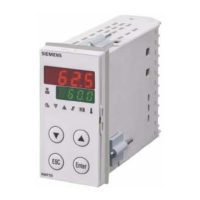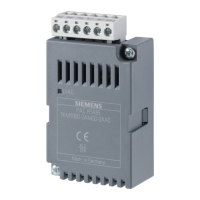60/126
Siemens Building Technologies Basic documentation RVD240 CE1P2384en
HVAC Products 15 Function block D.h.w. heating 27.05.2004
• No priority (parallel operation)
The priority (absolute or shifting) is made possible through generation of an uncritical
locking signal. It is generated during d.h.w. heating. Since there is no storage tank with
plant types x–4, the flow switch detects when d.h.w. is heated.
If no flow switch is installed, a locking signal is generated as soon as a valid demand
for d.h.w. is present
The impact of the locking signals on the heating circuits / heat converters is described
in chapter "21 Locking signals".
15.6.2 Absolute priority
During d.h.w. heating, the heating circuits are locked, that is, they receive no heat.
Setting on operating line 106 = 0
During d.h.w. heating, the controller generates an internal uncritical locking signal of
100 % (fixed value) and sends it to its own consumers.
In addition to the behavior described above without LPB link, the controller signals its
primary controller or heat source (consumer master from which it receives heat) via bus
that it currently provides d.h.w. heating with absolute priority. In that case, the con-
sumer master sends an uncritical locking signal of 100 % (fixed value) via bus to all
controllers in the same segment. If the consumer master is in segment 0, the locking
signal will be delivered to all controllers in the interconnected system.
The RVD240 has no consumer master functionality.
If there is no consumer master, absolute priority is the same as that with a controller
without LPB link.
15.6.3 Shifting priority
During d.h.w. heating, the amount of heat supplied to the heating circuits will be throt-
tled should d.h.w. heating produce a shortage of heat. Generation of the valid flow tem-
perature setpoint can be selected by making a setting on operating line 106:
1 = the flow temperature setpoint will be determined by the demand for d.h.w.
2 = the flow temperature setpoint will be determined by a maximum selection of the
valid demands for heat
In the case of shifting priority, the controller is able to generate and send a controller-
internal uncritical locking signal in the range of 0…100 % to its own consumers if the
capacity for d.h.w. heating is no longer sufficient.
• With plant types x–3, x–8 and x–9, the differential of flow temperature setpoint and
actual flow temperature is integrated for generating a locking signal corresponding to
the integral value.
• With plant type x–4, the maximum return temperature and actual value of the return
temperature from the return sensor are used, since there is neither a flow tempera-
ture setpoint nor an actual value of the flow temperature. If there is no return sensor,
it is not possible to have shifting priority and no locking signal will be generated.
• With plant types x–1, x–2 and x–6, the differential of flow temperature setpoint and
actual flow temperature of the internal heat converter is integrated for generating a
locking signal corresponding to the integral value.
In addition to the behavior described above and with all plant types, the controller signals
its primary controller or heat source (consumer master from which it receives heat) via
bus that is currently provides d.h.w. heating with shifting priority. If, now, the boiler is not
able to maintain its setpoint, the differential between setpoint and actual value will be
Introduction
Controllers without LPB
link
Controllers with LPB link
General
Controllers without LPB
link
Controllers with LPB link

